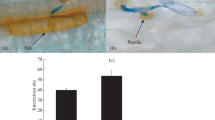Abstract
Barley plants can be infected by a variety of fungal pathogens with different lifestyles. The biotrophic Blumeria graminis, necrotrophic Pyrenopora teres, and hemibiotrophic Cochliobolus sativus are economically important pathogens of barley worldwide. Currently, the mechanisms underlying resistance to these diseases are still largely unknown. In the current study, expression patterns of some well-known pathogenesis-related (PR) genes were monitored at early points of infection in resistant and susceptible barley genotypes using quantitative PCR method. Data showed earlier and higher accumulation of PR transcripts in the resistant genotype as compared with the susceptible one, and the expression patterns of the same defense-associated genes were altered in adaptation to each pathogen. The most outstanding differences were observed in PR1 and PR5 genes that were highly activated in resistant plants infected with the hemibiotrophic pathogen rather than the biotrophic and necrotrophic ones. The barley defense response mechanisms against these pathogens could be in agreement with the well-accepted concept that these events are intense in the resistant cultivar. This work might provide useful information for a deeper molecular research on barley defense responses toward pathogens with different lifestyles.


Similar content being viewed by others
References
Abu Qamar M, Liu ZH, Faris JD, Chao S, Edwards MC et al (2008) A region of barley chromosome 6H harbors multiple major genes associated with the net type net blotch resistance. Theor Appl Genet 117:1261–1270
Akiyama T, Jin S, Yoshida M, Hoshino T, Opassiri R, Cairns JRK (2009) Expression of an endo-(1,3;1,4)-beta-glucanase in response to wounding, methyl jasmonate, abscisic acid and ethephon in rice seedlings. J Plant Physiol 166:1814–1825
Al-Daoude A, Jawhar M, Al-Shehadah E, Shoaib A, Orfi M, Arabi MIE (2018) Salicylic acid and pathogenesis-related gene (PR2) changes during barley–Pyrenophora teres interaction. Hell Plant Prot J 11:71–77
Andersen EJ, Ali S, Reese NR, Yen, Neupane S, Nepal MP (2016) Diversity and evolution of disease resistance genes in barley (Hordeum vulgare L.). Evol Bioinform Online 12:99–108
Arabi MIE (2005) Inheritance of partial resistance to spot blotch of barley. Plant Breed 124:605–607
Arabi MIE, Jawhar M (2004) Identification of Cochliobolus sativus (spot blotch) isolates expressing differential virulence on barley genotypes in Syria. J Phytopathol 152:461–464
Arabi MIE, Jawhar M (2012) Expression of resistance to Blumeria graminis in barley genotypes (Hordeum vulgare L.) under field and controlled conditions. J Plant Biol Res 1:107–112
Arabi MIE, Al-Safadi B, Charbaji T (2003) Pathogenic variation among isolates of Pyrenophora teres the causal agent of barley net blotch. J Phytopathol 151:376–382
Chaure P, Gurr SJ, Spanu P (2000) Stable transformation of Erysiphe graminis an obligate biotrophic pathogen of barley. Nat Biotechnol 18:205–207
Derveaux S, Vandesompele J, Hellemans J (2010) How to do successful gene expression analysis using real-time PCR. Methods 50:227–230
Doehlemann G, Wahl R, Vranes M, De Vries RP, Kämper J, Kahmann R (2008) Establishment of compatibility in the Ustilago maydis/maize pathosystem. J Plant Physiol 165:29–40
Glazebrook J (2005) Contrasting mechanisms of defense against biotrophic and necrotrophic pathogens. Annu Rev Phytopathol 43:205–227
Hückelhoven R (2005) Powdery mildew susceptibility and biotrophic infection strategies. FEMS Microbiol Lett 245:9–17
Kabbage M, Yarden O, Dickman MB (2015) Pathogenic attributes of Sclerotinia sclerotiorum: switching from a biotrophic to necrotrophic lifestyle. Plant Sci 233:53–60
Lee SJ, Rose JKC (2010) Mediation of the transition from biotrophy to necrotrophy in hemibiotrophic plant pathogens by secreted effector proteins. Plant Signal Behav 5:769–772
Livak KJ, Schmittgen TD (2001) Analysis of relative gene expression data using real-time quantitative PCR and the 2-ΔΔCT method. Methods 25:402–408
Mathre DE (1997) Compendium of barley diseases, 2nd edn. APS Press, St. Paul, MN
Moseman JG, Baenziger PS, Kilpatrick RA (1981) Genes conditioning resistance of Hordeum spontaneum to Erysiphe graminins f. sp. hordei. Crop Sci 21:229–232
Murillo I, Cavallarin L, Segundo BS (1999) Cytology of infection of maize seedlings by Fusarium moniliforme and immunolocalization of the pathogenesis-related PRms protein. Phytopathology 89:737–747
Nayanakantha NMC, Rawat S, Ali S, Grover A (2016) Differential expression of defense-related genes in Sinapis alba and Brassica juncea up on the infection of Alternaria brassicae. Trop Agric Res 27:123–136
Neu E, Domes HS, Menz I, Kaufmann H, Linde M, Debener T (2019) Interaction of roses with a biotrophic and a hemibiotrophic leaf pathogen leads to differences in defense transcriptome activation. Plant Mol Biol 99:299–316
Panstruga R (2003) Establishing compatibility between plants and obligate biotrophic pathogens. Curr Opin Plant Biol 6:320–326
Poudel RS, Al-Hashel AF, Gross T, Patrick Gross P, Brueggeman R (2018) Pyramiding rpg4- and Rpg1-mediated stem rust resistance in barley requires the Rrr1gene for both to function. Front Plant Sci 9:1789
Spanu PD, Panstruga R (2017) Editorial: biotrophic plant-microbe interactions. Front Plant Sci 8:192
Tekauz A (1985) A numerical scale to classify reactions of barley to Pyrenophora teres. Can J Plant Pathol 7:181–183
Tian C, Wang Y, Yu H, He J, Wang J, Shi B, Du Q, Provart NJ, Meyerowitz EM, Jiao Y (2019) A gene expression map of shoot domains reveals regulatory mechanisms. Nature Comm 10:141
van Loon LC, Rep M, Pieterse CMJ (2006) Significance of inducible defense-related proteins in infected plants. Annu Rev Phytopathol 44:135–162
Acknowledgements
The authors thank the Director General of AECS and the Head of Molecular biology and Biotechnology Department for their support this research.
Author information
Authors and Affiliations
Corresponding author
Additional information
Communicated by H. Grausgruber.
Rights and permissions
About this article
Cite this article
Al daoude, A., Shoaib, A., Al-Shehadah, E. et al. Pathogenesis-related genes responses in barley plants challenged with pathogenic fungi with different lifestyles. CEREAL RESEARCH COMMUNICATIONS 48, 341–346 (2020). https://doi.org/10.1007/s42976-020-00047-8
Received:
Accepted:
Published:
Issue Date:
DOI: https://doi.org/10.1007/s42976-020-00047-8




